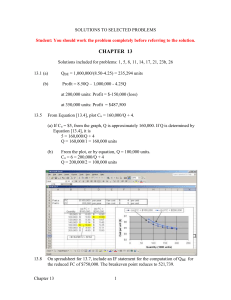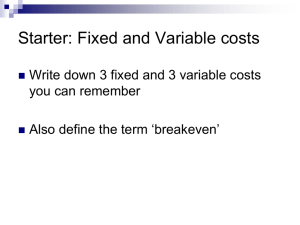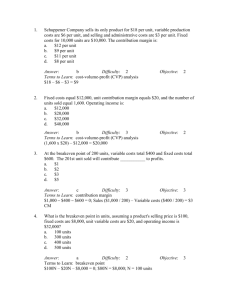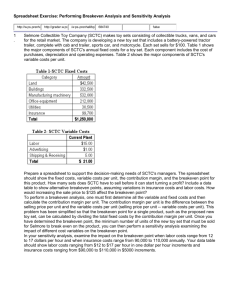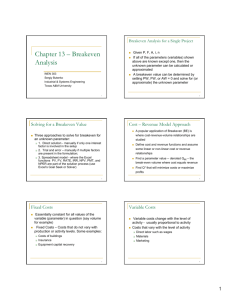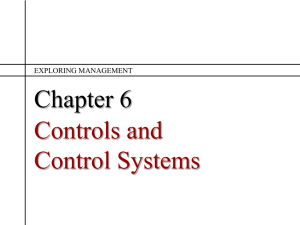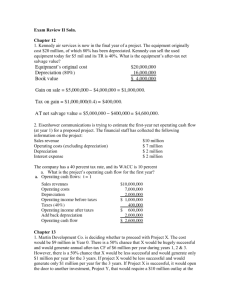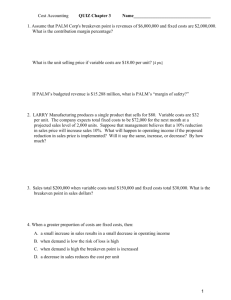IE463 Engineering Economics
advertisement
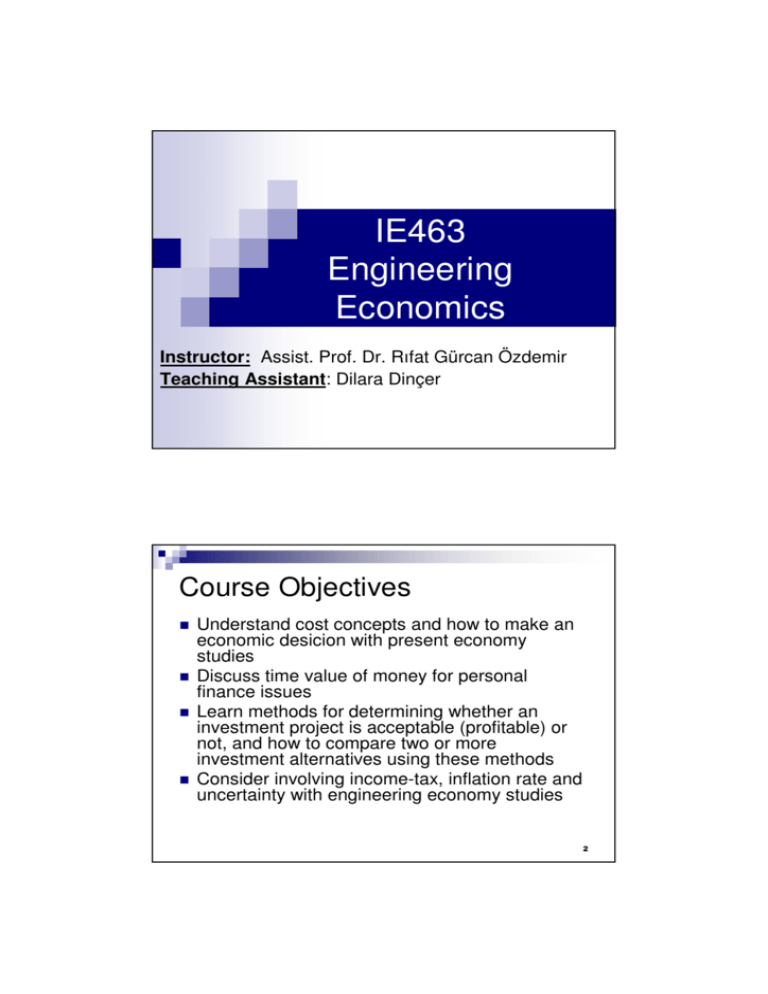
IE463 Engineering Economics Instructor: Assist. Prof. Dr. Rıfat Gürcan Özdemir Teaching Assistant: Dilara Dinçer Course Objectives Understand cost concepts and how to make an economic desicion with present economy studies Discuss time value of money for personal finance issues Learn methods for determining whether an investment project is acceptable (profitable) or not, and how to compare two or more investment alternatives using these methods Consider involving income-tax, inflation rate and uncertainty with engineering economy studies 2 Course Materials Text Book: William G. Sullivan, Wicks and Koelling Prentice Hall; 14 edition (May 13, 2008) Lecture notes: Power point slides (to be published via course web page) http://web.iku.edu.tr/~rgozdemir/IE463/index(IE463).htm 3 Course Topics Chapter 1: (Chapter 2 in the Text Book) Cost concepts and present economy studies Chapter 2: (Chapter 4 in the Text Book) Time value of money Chapter 3: (Chapters 5&10 in the Text Book) Investmet appraisal (evaluating a single project) 4 Course Topics Chapter 4: (Chapters 6&10 in the Text Book) Comparison among alternatives Chapter 5: (Chapter 7 in the Text Book) Depreciation and income taxes Chapter 6: (Chapter 8 in the Text Book) Price change and inflation rate Chapter 7: (Chapters 11&12 in the Text Book) Dealing with uncertainty 5 Grading Exams (80% of total grade) Quizzes Midterm Final (15%) (30%) (35%) Assignments (15% of total grade) Participation (5% of total grade) 6 IE463 – Chapter 1 Cost concepts and present economy studies COST CONCEPTS Fixed / Variable Costs – If costs change appreciably with fluctuations in business activity, they are “variable.” Otherwise, they are “fixed.” A widely used cost model is: Total Costs = Fixed Costs + Variable Costs Some examples of fixed costs: Insurance, taxes on facilities, administrative salaries, rental payments and initial setup or installation. Some examples of variable costs: direct labor, direct material, unit transportation. 8 Example 1.1 In connection with surfacing a new highway, a contractor has a choice of two sites on which to set up the mixing plant equipment. The contractor estimates that it will cost $1.15 per cubic meter per kilometer to haul the asphalt paving material from the mixing plant to the job site. If site B is selected, there will be an added charge of $96 per day for a flagman The job requires 50,000 cubic meters of mixed asphalt paving material. It is estimated that four months (17 weeks of five working days per week) will be required for the job 9 Example 1.1 (continued) Cost Factors Average hauling distance Site A 6 km Site B 4.3 km Monthly rental of site $1000 $5000 Cost to setup and remove equipment $15000 $25000 Hauling expense $1.15 / m3/km $1.15 / m3/km a) Compare the two sites in terms of their fixed, variable, and total costs. b) For the selected site, how much profit can be made if it is paid $8.05 per cubic meter delivered to the job site? 10 Example 1.1 (solution to a) Fixed Costs Site A Site B $1000 x 4 $5000 x 4 $15,000 $25,000 0 $96 x 85 $19,000 $53,160 Variable Costs Site A Site B Hauling expense m3/km Monthly rental of site Cost to setup and remove equipment Flagman wage Total Fixed Costs Total Costs Fixed + Variable $1.15 / x 6 km x $1.15 / m3/km x 4.3 km x 3 50,000 m = $345,000 50,000 m3 = $247,250 Site A Site B $364,000 $300,410 11 Example 1.1 (solution to b) PROFIT = REVENUE – TOTAL COST REVENUE = $8.05 / m3 (50,000 m3) = $402,500 PROFIT = $402,500 – $300,410 = $102,090 12 BREAKEVEN ANALYSIS Notation TR = Total Revenue CT = Total Cost CF = Fixed Cost CV = Varaible Cost v = Unit Variable Cost per unit p = Price per unit Q = Demand (output rate) 13 BREAKEVEN ANALYSIS 14 BREAKEVEN ANALYSIS at BREAKEVEN point (QBE), TR = CT, so NO LOSS & NO PROFIT p(Q) = CF + v(Q), Q BE = CF , p−v for p > v. if DEMAND (Q) > QBE , then PROFIT if DEMAND (Q) < QBE , then LOSS 15 Example 1.3 An engineering consulting firm measures its output in a standard service hour unit. The variable cost (v) is $62 per standard service hour. The charge-out rate (i.e., selling price “p”) is 1.38v = $85.56 per hour. The maximum output of the firm is 160,000 hours per year, and its fixed cost (CF) is $2,024,000 per year. For this firm, a) b) What is the breakeven point in standard service hours and in percentage of total capacity? What is the percentage reduction in the breakeven point (sensitivity) if fixed costs are reduced 10%? 16 Example 1.3 (solution to a) Q BE = CF $2,024 ,000 = = 85,908 hours p − v $85.56 / hour − $62 / hour 17 Example 1.3 (solution to a) Q BE % = Q BE 85,908 hours = = 0.54 = 54% of total CAPACITY total CAPACITY 160,000 hours 18 Example 1.3 (solution to a) if CF is reduced by 10%, newQBE = ? and (QBE – newQBE) / QBE = ? reduced CF = CF (1 – 0.1) = $2,024,000 (0.9) = $1,821,600 newQ BE = reduced CF $1,821,600 = = 77 ,318 hours p−v $85 .56 / hour − $62 / hour % reduction in Q BE = Q BE − newQ BE 85,908 hrs − 77 ,318 hrs = = 10 % Q BE 85,908 hrs 19 The General Price-Demand Relationship 20 The General Price-Demand Relationship The relationship between price and demand can be expressed as a linear function: Q = a/b – p(1/b) = (a – p) / b or p = a – bQ for 0 ≤ Q ≤ a / b, and a>0, b>0 where p = price per unit Q = demand for the product or service (# of units) a = base (maximum) price (intercept on the price axis) b = slope of the price-Demand line 1/b = amount by which demand increases for each unit decrease in price 21 The Total Revenue Function TR = (price per unit) x (demand) = pQ TR = (a - bQ)Q = aQ - bQ2 for 0 ≤ Q ≤ a / b where p = price per unit Q = demand for the product or service (# of units) a = base (maximum) price (intercept on the price axis) b = slope of the price-Demand line 22 The Total Revenue Function 23 Nonlinear Breakeven Analysis Profitable Domain QBE-1 < Q(demand) < QBE-2 24 Breakeven Points TR = CT TR – CT = 0 TR = aQ – bQ2 and CT = CF + vQ – bQ2 + (a – v)Q – CF = 0 Q BE −1, 2 = − ( a − v ) ± ( a − v ) 2 − 4( −b )( −CF ) 2 ( −b ) 25 Profit Function PROFIT = TR – CT = – bQ2 + (a – v)Q – CF for 0 ≤ Q ≤ a / b, and a>0, b>0 26 Optimal Production Quantity PROFIT = TR – CT = – bQ2 + (a – v)Q – CF d ( PROFIT ) =0 dQ ⇒ −2bQ + ( a − v ) = 0 Q *= d 2 ( PROFIT ) <0 dQdQ ⇒ (a − v) 2b −2b < 0, for b > 0 It proves that Q* maximizes profit 27 Example 1.6 A company produces an electronic timing switch that is used in consumer and commercial products made by several other manufacturing firms. The fixed cost (CF) is $73,000 per month, and the variable cost (v) is $83 per unit. The selling price per unit is p = $180 – 0.02Q. For this situation; a) Find the volumes at which breakeven occurs; that is, what is the domain of profitable demand? b) Determine the optimal volume for this product in order to maximize profit. c) What is the maximum profit per month at the optimal volume? 28 Example 1.6 (solution to a) TR = CT or Profit = 0 Profit = TR – CT = pQ – CF – vQ = 0 Profit = (180 – 0.02Q)Q – 73,000 – 83Q = 0 – 0.02Q2 + (180 – 83) Q – 73,000 = 0 Q BE −1 = Q BE − 2 = − 97 + (97 ) 2 − 4( −0.02 )( −73,000 ) 2( −0.02 ) − 97 − (97 ) 2 − 4( −0.02 )( −73,000 ) 2( −0.02 ) = 932 units / month = 3,918 units / month The domain of profitable demand per month = 932 units to 3,918 units 29 Example 1.6 (solution to b) Profit = (180 – 0.02Q)Q – 73,000 – 83Q Profit = – 0.02Q2 + (180 – 83) Q – 73,000 Take first derivative and set = 0 dProfit / dQ = 0 – 0.04Q + 97 = 0 Q* = 2,425 units /month (# of products that maximizes profit) d2Profit / dQdQ = – 0.04 < 0 It proves that Q* maximizes profit 30 Example 1.6 (solution to c) Use equation for profit and Q* = 2,425 units /month, Profit = (180 – 0.02Q)Q – 73,000 – 83Q Profit = – 0.02Q2 + (180 – 83) Q – 73,000 Maximum Profit = – 0.02(2,425)2 + (97)(2,425) – 73,000 Maximum Profit = $44,612 /month 31 Cost Driven Design Optimization 1. 2. 3. 4. Identify the design variable that is the primary cost driver. Express the cost model in terms of the design variable. For continuous cost functions, differentiate to find the optimal value. For discrete functions, calculate cost over a range of values of the design variable. Solve the equation in step 3 for a continuous function. For discrete, the optimum value has the minimum cost value found in step 3. A simplified cost function. where, a is a parameter that represents the directly varying cost(s), b is a parameter that represents the indirectly varying cost(s), k is a parameter that represents the fixed cost(s), and X represents the design variable in question. Example 2.6 on pg.59 How fast should the airplane fly? C O = operating cost = k ⋅ n ⋅ v 3 2 where, k = a constant of proportionality n = the trip length in miles v = velocity in mile per hour n C C = time cost = 300 ,000 v 34 Solution n C T = C O + C C = k ⋅ n ⋅ v 3 2 + 300 ,000 v dC T 3 n = 0 → k ⋅ n ⋅ v 1 2 − 300 ,000 2 = 0 dv 2 v k = 0 .0375 → 0 . 05625 v 5 2 − 300 ,000 = 0 300 , 000 v = 0 .05625 * 0.4 = 490 .68 mph. 35 Present Economy Studies Alternatives are being compared over one year or less. When revenues and other economic benefits vary among alternatives, choose the alternative that maximizes overall profitability of defect-free output. When revenues and other economic benefits are not present or are constant among alternatives, choose the alternative that minimizes total cost per defect-free unit. Example 2.9 on pg.64 Production rate Machine A 100 parts/hour Machine B 130 parts/hour Available hours Defective ratio 7 hours/day 3% 6 hours/day 10% Material cost = $6 per part Selling price = $12 per part Operator cost = $15 per hour Overhead cost = $5 per hour (a) Which machine should be selected? (b) What is the breakeven defective ratio? 37 Solution to (a) Machine A: Profit = (100)(7)(12)(1 – 0.03) – (100)(7)(6) – (7)(20) = $ 3,808 per day Machine B: Profit = (130)(6)(12)(1 – 0.10) – (130)(6)(6) – (6)(20) = $ 3,624 per day Therefore, select machine A to maximize profit per day 38 Solution to (b) X, breakeven defective ratio for machine B Profit = (130)(6)(12)(1 – X) – (130)(6)(6) – (6)(20) = 3,808 X= 0.08 39

